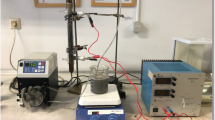Abstract
High concentration of heavy metals is toxic for most microorganisms and cause strict damage in wastewater treatment operations and often a physico-chemical pretreatment prior to biological treatment is considered necessary. However, in this study it has been shown that biological systems can adapt to Ni (II) and Cr (VI) when their concentration is below 10 and 20 mg/L, respectively. The aim of this study was to evaluate the effect of Ni (II) and Cr (VI) on the lab-scale rotating biological contactor process. It was found that, addition of Ni (II) up to 10 mg/L did not reduce the chemical oxygen demand removal efficiency and on the contrary concentrations below 10 mg/L improved the performance. The influent Ni (II) concentration of 1 mg/L was the concentration where the treatment efficiency produced a maximum COD removal of 86.5%. Moreover, Ni (II) concentration above 10 mg/L was relatively toxic to the system and produced lower treatment efficiencies than the baseline study without Ni (II). Turbidity and suspended solids removals were not stimulated to a great extent with nickel. Addition of Ni (II) did not seem to affect the pH of the system during treatment. The dissolved oxygen concentration did not drop below 4 mg/L at all concentrations of Ni (II) indicating aerobic conditions prevailed in the system. Experiments conducted with Cr (VI) revealed that addition of Cr (VI) up to 20 mg/L did not reduce the COD removal efficiency and on the contrary concentrations below 20 mg/L improved the performance. The influent Cr (VI) concentration of 1 mg/L was the concentration where the treatment efficiency produced a maximum COD removal of 88%. Turbidity and SS removals were more efficient at 5 mg/L Cr (VI) concentration, rather than 1 mg/L, which lead to the conclusion that 5 mg/L Cr (VI) concentration is the optimum concentration, in terms of COD, turbidity and SS removals. Similar with Ni (II) experiments, addition of Cr (VI) did not significantly affect the pH value of the effluent. The DO concentration remained above 5 mg/L.





Similar content being viewed by others
References
Bagby MM, Sherrard JH (1981) Combined effects of cadmium and nickel on the activated sludge process. J Water Pollut Control Fed 53:1609–1619
Chua H, Hua FL (1996) Effects of heavy metal on organic adsorption capacity and organic removal in activated sludge. Appl Biochem Biotechnol 57(58):845–849
Stasinakis AS, Mamais D, Thomaidis NS, Lekkas TD (2002) Effect of chromium (VI) on bacterial kinetics of heterotrophic biomass of activated sludge. Water Res 36:3341–3349. doi:10.1016/S0043-1354(02)00018-0
Yetiş Ü (1988) Effect of Ni (II) and Cr (VI) on activated sludge kinetics. PhD Thesis, Middle East Technical University (METU), Ankara, Turkey
Ong SA, Toorisdaka E, Hirata M, Hano T (2004) Effects of nickel (II) addition on the activity of activated sludge microorganisms and activated sludge process. J Hazard Mater 113:111–121. doi:10.1016/j.jhazmat.2004.05.031
Knoetze A, Davies D, Wiecher S (1980) Chemical inhibition of biological nutrient removal process. Water SA 6:171–180
Zoss SJ (1987) The effects of trace metals on the operation of rotating biological contactors. Dissert Abst Inter 47:2824B
Costley SC, Wallis FM (2000) Effect of flowrate on heavy metal accumulation by rotating biological contactor biofilms. J Ind Microbiol Biotechnol 24:244–250. doi:10.1038/sj.jim.2900812
Costley SC, Wallis FM (2001) Treatment of heavy metal-polluted wastewaters using the biofilms of a multistage rotating biological contactor. World J Microbiol Biotechnol 17:71–78. doi:10.1023/A:1016621508477
Shoou-Yuh C, Ju-Chang H, Yow-Chyun L (1986) Effects of Cd (II) and Cu (II) on a biofilm system. J Environ Eng 112:94–104
Gibbs CR (1983) Introduction to chemical oxygen demand. Technical Information Series, Booklet No:8, Hach Co., USA
Standard Methods (1972) Standard methods for the examination of water and wastewater. American Public Health Assocaition, USA
Shen H, Wang Y (1995) Simultaneous chromium reduction and phenol degradation in a co culture of Escherichia coli ATCC 33456 and Pseudomonas putida DMP-1. Appl Environ Microbiol 61:2754–2758
Author information
Authors and Affiliations
Corresponding author
Rights and permissions
About this article
Cite this article
Taşeli, B.K., Gökçay, C.F. & Gürol, A. Influence of nickel (II) and chromium (VI) on the laboratory scale rotating biological contactor. J Ind Microbiol Biotechnol 35, 1033–1039 (2008). https://doi.org/10.1007/s10295-008-0379-9
Received:
Accepted:
Published:
Issue Date:
DOI: https://doi.org/10.1007/s10295-008-0379-9




